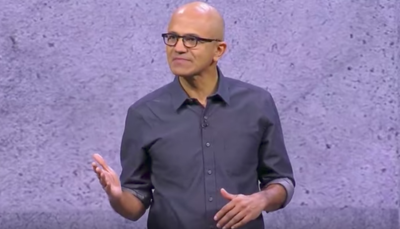While Microsoft’s ability to reach $6 billion in quarterly cloud revenue and $20.8 billion for the trailing 12 months is beyond impressive, what’s downright scary is that Satya Nadella’s cloud business is growing at a stunning 58%–and the enterprise cloud hasn’t even begun to reach the fat part of the market.
Look at Amazon’s Q1 cloud numbers: remarkable 49% growth to $5.44 billion in revenue, huge momentum in all of its businesses—and not only does it fail to gain ground on Microsoft, but Amazon, in fact, fell farther behind!
So what’s the secret behind the Microsoft Cloud and Azure and the company’s ability to produce hypergrowth at a scale that is simply hard to fathom in today’s business-to-business world?
Why is Microsoft’s strategy relentlessly ascendant despite world-class competition from not only Amazon but also IBM, Salesforce, SAP, Oracle and others?
In a time when many so-called experts are swept up in pushing the misguided notion that Amazon and Google dominate the cloud while Microsoft is little more than a plucky striver, how does Microsoft continue to push not only new ideas for what the cloud might do, but also new levels of achievement for what it is, in fact, accomplishing for some of the world’s largest corporations?
From last week’s earnings call transcript, I’ve pulled 10 strategic insights offered by CEO Satya Nadella and CFO Amy Hood from the prepared remarks to analysts as well as their answers during the Q&A session.
While each offers some insights into what Microsoft is doing in specific areas, the real value comes from seeing what Nadella is achieving with Microsoft’s current capabilities and where he’s extending the boundaries of what’s possible for customers in the future:
- A single, unified, easy-to-use architecture ideally suited for digital transformation.
- Blending on-premises, cloud, IoT and more into a consistent and intelligent fabric.
- Tying formerly disparate pieces of Microsoft technology into elegant combinations that, together, can deliver more business than either could ever have achieved separately.
- Putting customers at the center of everything Microsoft does.
- Leveraging LinkedIn to transform the science of sales while also keeping its core member-centric ethos.
- Elevating AI from a technological shiny object to a business imperative.
And as you read these 10 drivers, bear in mind one of Nadella’s comments from the earnings call: “We’re still in the early innings of the cloud transition.”
- The power of richly integrated IaaS, PaaS and SaaS. Asked about where Azure’s surging growth is coming from, Nadella offered this as part of his reply: “One of the things that’s happening is there is growth in Azure across each of the layers. And I think I’ve said this before. Sometimes when you have new workloads and new customers on board they start within some sense the IaaS, but then scale to higher layer services like our Cosmos DB or even some of our compute higher-level services like in AI…And it’s true that we are at this point at scale on Azure and with very, very high growth rates. But as I said, I think the key things that we think about is differentiation of Azure at each level, because that’s what is super-important for us as we compete in this marketplace and more importantly double down on areas of differentiation we have. So the first thing is on the infrastructure side itself, with the combination of the edge and the cloud, I believe between Azure Stack and Azure, as well as the inclusion of our servers, we have the best crowd platform for what is going to be hybrid computing and we’ll continue to push on that…. The layer above that is the place which we are very excited about. We have seen lots of consecutive quarters of growth in our higher-level services, but we are now seeing some good scale.”
- Remaking the company: Intelligent Cloud to Intelligent Edge. “The intelligent cloud and the intelligent edge era is already upon us. It represents a tremendous opportunity. We took significant steps this quarter to put this at the forefront of everything we do. We’re realigning our entire engineering organization to accelerate innovation and better serve the needs of customers and partners.”
- Simplifying I.T. for customers: unified stack from cloud to edge. “Our architectural advantage of a consistent stack from the cloud to the edge is resonating with customers, with Azure revenue growth of 93 percent this quarter. Recent CIO surveys affirm our leadership position in hybrid, developer productivity, trusted security and compliance and new workloads such as IoT and AI at the edge.”
- Azure Cosmos Database hits $100-million annualized run-rate. Asked if Microsoft is starting to take share in the hotly contested data-management and database market, Nadella said the new Cosmos database is off to a great start. “I’ve been around databases for a long time—I’ve never seen a product that’s gotten to this kind of scale this quickly.” He later added, “This was actually a database we just launched last year. I mean, I’ve been around databases for a long time—I’ve never seen a product that’s gotten to this kind of scale this quickly.“
- Massive momentum for Azure among developers. With Azure Databricks, Nadella said, the move “to democratize AI” has led to “more than 1 million developers have already used cognitive services to quickly and easily create AI applications, and we have more services than any other cloud provider.” And, he added, “Our Azure Bot Service has nearly 300,000 developers, up more than 150 percent year-over-year.”
- Industrial IoT: “transforming the rules of manufacturing.” “We also continue to see strong customer demand for Azure Stack across industries and it’s unlocking new workload scenarios across hybrid and edge. Industrial IoT is transforming the rules of manufacturing, fueling cloud and edge innovation, accelerating the evolution of digital factories and enhancing supply chain performance… Azure IoT and Azure stack enable customers and partners to build industrial IoT solutions that run at the edge, so operators on the factory floor can manage devices and analyze data in real time… Our just announced Azure Sphere is the first of its kind highly secure edge solution that combines chip design and IoT operating system and a cloud service to secure more than nine billion microcontroller-powered devices entering the markets each year.”
- Areas of investment, and the primary driver of growth.From CFO Amy Hood: (a) Three core areas of investment are commercial sales capacity, cloud engineering, and LinkedIn. (b) We expect the total Azure revenue growth to reflect a balance of our continued strength in infrastructure, data and application services. (c) “Finally, I want to offer a few early thoughts on FY19. Assuming the macro environment remains consistent, many of the key drivers of our business should remain intact. Revenue growth will continue to be driven by the transition to cloud services.”
- “Still in the early innings of cloud transition.” Asked to describe future growth opportunities, Nadella said, “We’re still in the early innings of the cloud transition. We are investing aggressively whether it’s on the field side or on the CapEx side to attract more customers and more workloads per customer. So they will have that same profile, which is lower margin services first, higher margin services over time. That’s just inside of Azure. And of course, you combine that with the rest, one of the things that I think should be fairly clear is the high correlation between our services in Office 365, as well as Dynamics 365, around data— in particular with Azure. So that’s why we think of this as one cloud play.” Nadella also described how that “one cloud play” strategy is pulling the company’s IP together in new ways: “One of the areas of, in fact, real breakout growth and differentiation has been in Power BI, Power Apps and Flow. For the first time, in fact, in our own Microsoft history, we have an extensibility model that is the same for Office 365 and Dynamics 365. This has been a dream of mine, I don’t know, for 15 years probably. And we are finally here, and we are executing super-well.”
- Taking the burden of integration away from customers. Describing the business value of going with Microsoft across all three cloud layers, Nadella said, “But most importantly, it’s about architectural benefit for customers, because by having incoherence around these layers is where you may feel like you’re making some great best of breed sort of choices in individual layers, but you’ll bear that expense in your overall agility as well as your overall management of your data. And that’s where I think we’ll be very differentiated.” He later added, “But the interesting thing is it’s not just even for our own SaaS applications. It is the extensibility model for every SaaS application out there, including a common data model. So I think that that’s where the synergies lie, because AI starts with having a data estate that can really bring data from all of your application silos in some sense together, so that you can start building analytical power that you can then visualize and put it in the hands of people using Power BI, or run an AI model that does some prediction that you can deploy in your system, whether it’s forecasting, sales lead scoring, what-have-you.”
- Where the opportunity lies: AI and Data. “Cosmos DB is a pretty unique capability in combination with everything else we do in both the data layer, the AI layer, and the infrastructure layer. I think we have a tremendous opportunity, because, as I said, this AI era is mostly first a data era. And that’s where I think the opportunity lies.”
*******************
RECOMMENDED READING FROM CLOUD WARS:
The World’s Top 5 Cloud-Computing Suppliers: #1 Microsoft, #2 Amazon, #3 Salesforce, #4 SAP, #5 IBM
Amazon Versus Oracle: The Battle for Cloud Database Leadership
As Amazon Battles with Retailers, Microsoft Leads Them into the Cloud
Why Microsoft Is #1 in the Cloud: 10 Key Insights
SAP’s Stunning Transformation: Qualtrics Already “Crown Jewel of Company”
Watch Out, Microsoft and Amazon: Google Cloud CEO Thomas Kurian Plans To Be #1
The Coming Hybrid Wave: Where Do Microsoft, IBM and Amazon Stand? (Part 1 of 2)
Oracle, SAP and Workday Driving Red-Hot Cloud ERP Growth Into 2019
*********************
Subscribe to the Cloud Wars Newsletter for twice-monthly in-depth analysis of the major cloud vendors from the perspective of business customers. It’s free, it’s exclusive, and it’s great!








